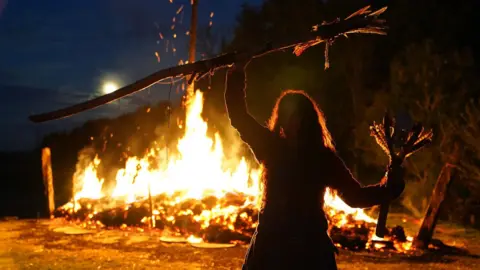 PA
PAThe peaceful rural village of Repton in Derbyshire is thought to have witnessed a pivotal blood-soaked moment in British history – and an expert says it deserves national recognition.
A chilling truth – which sounds like a cross between a horror movie and an apocalyptic thriller – hides behind a picture of quintessential English calm.
In the quiet shade of trees, children were buried, perhaps to honour hundreds of dead piled nearby.
Beneath a church spire, a royal shrine was torn apart. Under carefully tended turf, the mutilated members of a family.
And while the churchyard of St Wystan’s Church, in Repton, has witnessed centuries of history, these events may have taken place during a few, terrible, months in 873 AD at the hands of the Vikings under their infamous leader Ivar the Boneless and their most terrible iteration, the Great Heathen Army.
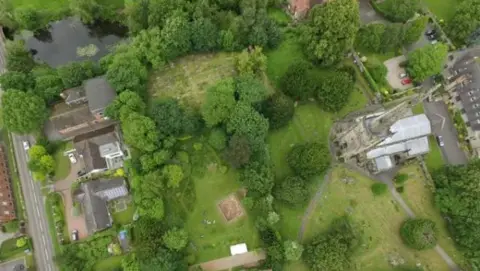 Cat Jarman
Cat Jarman“Repton is of quite extraordinary significance as a place where not only are we in touching distance of a sequence of almost mythological individuals and events,” said Steve Baker, Derbyshire County Archaeologist.
“Early saints, Mercian kings, figures from Viking sagas, the ‘Great Army’ itself – all in one location representing critical moments in the making of England as we know it, but we also know these events, figures and stories to be embodied in well-preserved and stratified archaeological evidence.
“Recognition of this importance through some form of national designation is long overdue.”
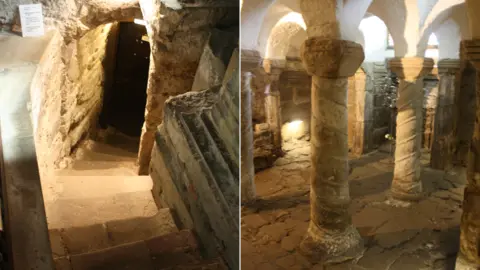
Repton’s story has been revealed in two main phases of archaeological work – in the 1970s and 1980s under Professor Martin Biddle and Birthe Kjølbye-Biddle, and then from 2016 to 2023 under Dr Cat Jarman.
Dr Tom Horne, who worked on the site during the most recent excavations, said: “Maybe you don’t get England as we know it without Repton.
“We know from a book called the Anglo Saxon Chronicle that the Great Heathen Army effectively wipes out the kingdoms of East Anglia, Northumbria and Mercia.
“It also tells us in the winter of 873, this army camped in Repton – but gives little more detail.
“So here we have this snapshot of an extraordinary group of people, changing the map of Britain and it turns out the site at Repton is really remarkably well preserved.”
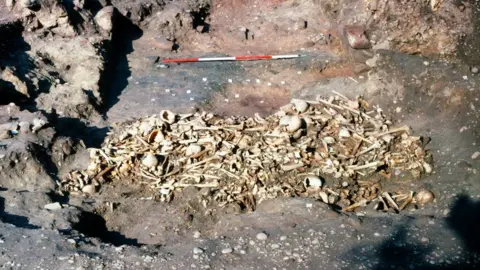 Martin Biddle
Martin BiddleAnd the story it preserves seems to live up the gruesome reputation of the Vikings.
A low mound near the churchyard was rumoured by folklore to have contained a giant skeleton, perhaps even Ivar himself.
The Biddle’s excavations of the mound found the remains of 264 adults, dating back to the late 9th Century, piled in the shattered remains of an Anglo Saxon monastery.
Nearby were four skeletons of children. Was this evidence of a massacre?
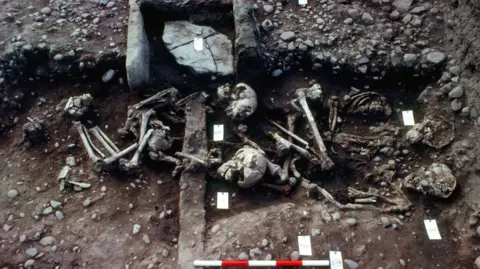 Martin Biddle
Martin BiddleDr Emma Brownlee from the University of Cambridge is an expert on funerary archaeology and also worked on the Repton site.
She said: “The large deposit of remains were not complete skeletons but a collection of disarticulated bones, suggesting they had been buried elsewhere then moved.
“This could well be that people who died on campaign were brought back to Repton for reburial, which indicates the area had special significance.
“It caused some surprise that, when the bones were analysed, one in five proved to be women. The army might well have more resembled a town on the move.
“There has been speculation the four adolescent skeletons nearby were sacrifices in honour of the mass grave but the true relationship remains unclear.
“But it is clearly a significant thing to do to gather up your dead and bring them here. Even if the army did not stay for long, this must have been a place of lasting importance.”
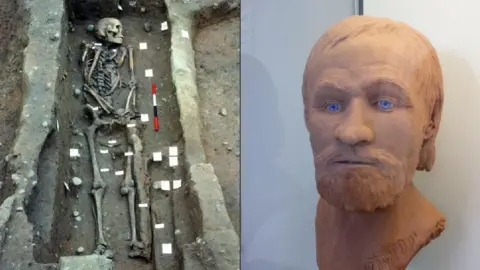 Martin Biddle/BBC
Martin Biddle/BBCThe importance of St Wystan’s to the Anglo-Saxons is shown by its crypt, a unique survival from the 8th Century. It is once thought to have held the tombs of Mercian kings but was likely ransacked, along with the neighbouring monastery, when the Vikings seized the town.
Its importance to the Vikings is shown by two graves found by the Biddles just outside the eastern end of the church, next to the crypt.
Dr Brownlee said: “One was an older man, the other younger. Both died violently, with the older suffering injuries to his head and leg. From the angle of the cut to his femur, it is likely this blow severed his genitals as well.
“He was buried with a sword, a Thor’s hammer pendant and a boar’s tusk, which as it sat between his legs, may have been a posthumous replacement for his genitalia. The grave goods and the position of the burial indicate these were high status individuals.
“Both graves were covered with stones, some of which belonged to a smashed Saxon cross, which may itself have been a statement of conquest.”
 PA
PALater DNA analysis by Dr Jarman showed the two men were closely related and it was theorised they could be Viking father and son Olaf and Eysteinn, mentioned in documents as being killed in 874 and 875, but this cannot be confirmed.
The more recent digs shed more light on the terrible events which the location has witnessed, perhaps uncovering ground walked on by the Great Army.
Dr Horne said: “Finds from a pebble path included the sort of thing one might expect to discover at a looted Anglo-Saxon Christian centre.
“There were spectacular copper alloy brooches with gilded surfaces, sherds of rare blue window glass and coins.
“You can interpret this as monks fleeing the oncoming storm or warriors spilling their loot, not bothering to pick up the small stuff as they had so much.
“The broken glass certainly suggests the shattered windows of an abbey so perhaps we are looking at traces of a landscape of destruction”.
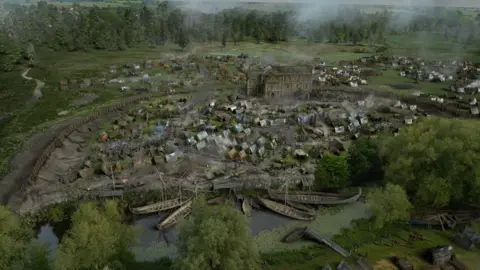 Compost Creative
Compost CreativeThe Biddles also found a large D-shaped ditch, incorporating the church, which would have defended a landing place for longships which had come up the old course of the River Trent.
So, everything pointed to a violent occupation of a Mercian royal and religious site by the Viking army. But one problem remained – a question of size.
Mr Baker said: “The Repton site, even taking in activity outside the ditch, is about one hectare.
“The previous winter the army stayed at Torksey in Lincolnshire and there the camp measured about 26 hectares.
“But following clues from metal detectorists, Cat Jarman looked at fields at a place called Foremark, a little over two miles away.
“Although the excavations were limited, enough was found to suggest there was a major Viking presence there.
“Suddenly you had space for the sort of army which destroyed kingdoms.”

But the countryside near Repton has another revelation about the Vikings, with a unique cemetery at a place called Heath Wood.
Dr Brownlees explains: “There are dozens of barrows or mounds here which are the site of cremation burials, the only example in the British Isles. The contrast to the inhumation – full skeleton – burials at Repton is striking and may indicate cultural differences within the Viking army.
“After this winter, the army split up, with part going to occupy the already conquered kingdoms, part going to face Alfred in Wessex and it has been suggested this was down to differences between the leaders.
“But Heath Wood, which was originally on a bare hill above the Trent valley, served a similar role to Repton, as a statement of domination.”
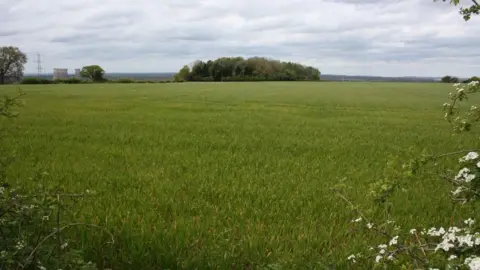
Steve Baker said: “The story has moved from just being in Repton, to a series of sites spread out across the Trent floodplain.
“These sites have hardly been investigated, so who knows what lies waiting to be discovered.
“We have tantalising glimpses of the people involved, people who destroyed most of the Anglo-Saxon kingdoms.
“But by dividing after Repton, only one part of the army went south and failed to conquer Alfred and Wessex. These events helped set much of Britain on a different path.”
Follow BBC Derby on Facebook, on X, or on Instagram. Send your story ideas to eastmidsnews@bbc.co.uk or via WhatsApp on 0808 100 2210.
Read More: Digs suggest leafy Repton once saw Viking horrors


